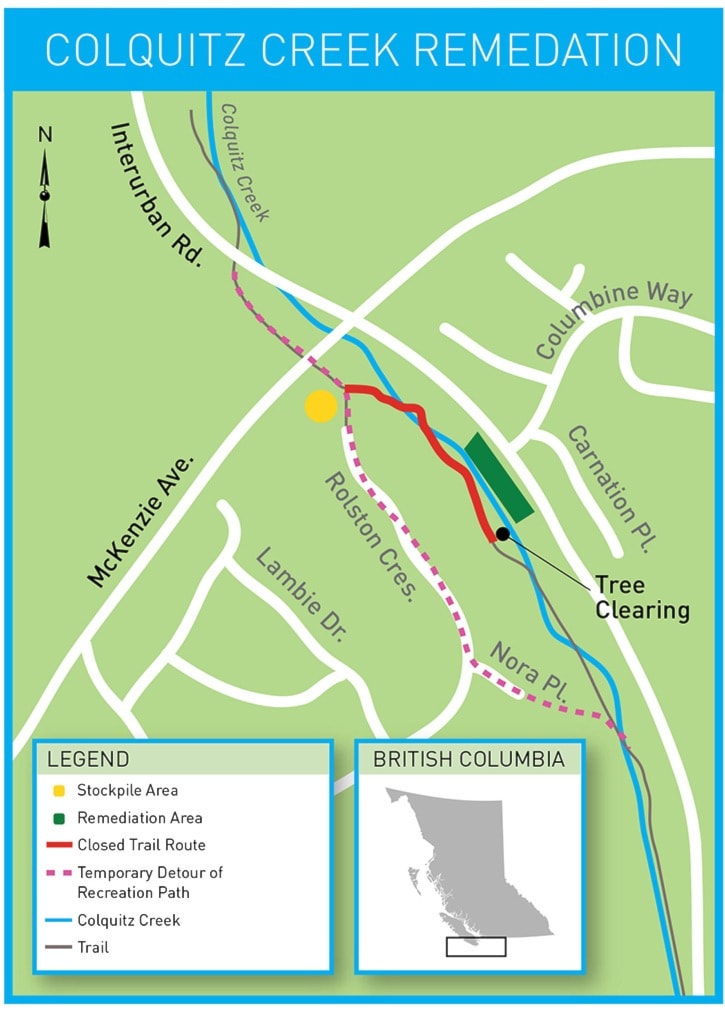B.C. Hydro plans to dig contaminated soil out of the Colquitz creek stream bank starting next week, in the wake of discovering mineral oil leaking from an underground power line last November.
A portion of trail in Colquitz River Park will be closed for more than a month as crews from Quantum Murray LP excavate a long leg of the eastern stream bank during a window of low fish activity. The work zone is opposite of Columbine Way on Interurban Road, and drivers can expect delays from Aug. 6 to Sept. 30, Monday to Saturday.
Saanich public works staff spotted a sheen of oil on Colquitz creek around Nov. 7 last year, which was traced to an underground high-voltage power line running parallel to the creek and Interurban Road.
B.C. Hydro describes the mineral oil as "low toxicity" and is used as an insulator in the cable that runs between downtown Victoria and a substation near Camosun Interurban. Oil escaped from the cable, a drip every few seconds, although B.C. Hydro said its unclear how long it had been leaking or how much oil leaked into the environment.
Volunteers who monitor the Colquitz fish run and ecosystem say that portion of the creek had a consistent, mysterious sheen for long time. Colquitz steward Chris Bos saw an oily sheen on the creek in February 2012 when meeting fisheries officials regarding the juvenile fish count.
"It's been a source of concern for some time," Bos said. "For months oil migrated slowly into the river. We saw an oily sheen with no apparent major spill upstream. Saanich constantly had oil booms across the river but weren't able to stop the source."
Dorothy Chambers, a steward who helps run a Colquitz creek education program for school kids, said an oily sheen in the creek through Colquitz River Park has appeared for a number of years. It's not clear if the sheen is related to mineral oil from the transmission line, or other source, such as leaky home oil heating tanks.
"When we talk about different areas of the river, this area is called the 'chronic leak,'" Chambers said. "For six or seven years there's been dirty old booms strung across the creek. A lot of time has been invested to find the smell and the source that hasn't been identifiable."
Karla Louwers, with B.C. Hydro, said internal oil monitors within the cable didn't trigger, and it remains unknown how much fluid escaped. "It was brought to our attention in November, we placed containment within the creek and did emergency repairs to stop the leak," she said.
From November to present day, B.C Hydro environmental consultants have kept tabs on the creek and absorbent booms on a daily basis, Louwers said, and tested the water, soil, vegetation and surveyed aquatic life to develop a course of action for remediation.
Crews will start removing vegetation and trees along 26 metres of park next week in advance of excavation. B.C. Hydro plans to remove 350 cubic metres of contaminated soil and another 350 cubic metres of buffer – some 46 dump-truck loads of earth.
Work will also involve damming and diverting the creek using pipes to allow potential removal of creek bed soil, and allow the backhoe to reach the stream bank. "It will be a construction zone," Louwers said. "That's why a portion of the trail will be closed."
When excavation is complete, clean earth will be backfilled into the stream bank, and reenforced with a vegetation wall constructed by by noted environmental restoration expert Dave Polster, of Duncan.
"(Mineral oil) is not near the environmental threat as oil is normally associated with, but we are sensitive about the Colquitz," said Saanich Mayor Frank Leonard. "Ourselves and the volunteers are proud of the comeback the Colquitz has made, and we're pleased to see B.C. Hydro stepping up with remediation."
Bos and Chambers also remarked that B.C. Hydro has done well to consult with creek stewards and the municipality to draw up a remediation strategy.
"I think this remediation is far better thought out and inclusive with the people who understand the waterway environment," Chambers said. "Saanich has heard and B.C. Hydro has heard that this is an incredibly fragile and a miracle urban creek that has migrating and spawning salmon. It's not a ditch.
"B.C. Hydro has gone through great lengths to do things right, and have included people who are in the trenches."
The project has a work window from Aug. 15 to Sept. 15 to minimize impacts on migrating fish. Colquitz is home to 300 to 500 spawning coho per year, and occasionally chum and cutthroat.
"There are fish in the system upstream and there may be fish in the system, but this will be minimum impact, there's no juveniles migrating," Bos said. "It's the best time of year."
Holding up the road
Soil excavation and remediation along Colquitz creek is just north of another recently finished construction project next to Colquitz River Park earlier this year.
Orange fencing is still visible where B.C. Hydro used shotcrete to shore up a crumbling stream bank that supported a span of Interurban Road. Part of the road itself was at risk of slumping and crushing the same 230 kV underground cable that leaked oil into the creek.
That project used cement to stabilize the slope, as opposed to trees and vegetation planned for the remediation project. Louwers said said B.C. Hydro had to act quickly to "protect the integrity of the transmission system and the road."
That particular transmission line under Interurban Road feeds power to 75,000 customers in Greater Victoria, including such institutions as the Royal Jubilee Hospital and the University of Victoria. Louwers described the cable as "an important piece of the (power) system," in the city.
editor@saanichnews.com
